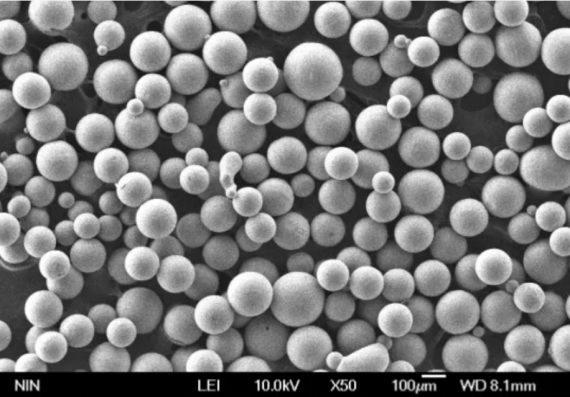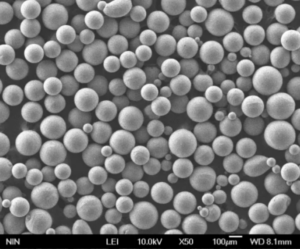Poudre de FeCoNiCrl'alliage de fer, un alliage à haute entropie (HEA), gagne en importance dans la fabrication de pointe, la science des matériaux et les applications industrielles en raison de ses propriétés exceptionnelles. Connue pour sa polyvalence et ses performances robustes, cette poudre d'alliage métallique est composée de fer (Fe), de cobalt (Co), de nickel (Ni) et de chrome (Cr). Que vous soyez ingénieur, chercheur ou fabricant, la compréhension de la poudre FeCoNiCr peut transformer vos processus et vos applications.
Dans cet article, nous allons approfondir la composition, les caractéristiques, les applications, les avantages et les limites de la poudre de FeCoNiCr. Nous comparerons également les différents modèles et grades, discuterons des options des fournisseurs et répondrons aux questions les plus fréquentes.

Aperçu de la poudre de FeCoNiCr
La poudre FeCoNiCr appartient à la famille des alliages à haute entropie, qui sont des systèmes à éléments multiples dont les proportions sont presque égales. Cette composition unique se traduit par une solidité, une résistance à la corrosion, une stabilité thermique et une résistance à la fatigue exceptionnelles - des qualités très recherchées dans les applications d'ingénierie critiques.
Les détails clés en un coup d'œil
| Propriété | Détail |
|---|---|
| Éléments | Fer (Fe), Cobalt (Co), Nickel (Ni), Chrome (Cr) |
| Catégorie | Alliage à haute entropie (HEA) |
| Applications | Aérospatiale, automobile, biomédical, outillage, stockage d'énergie |
| Points forts | Excellentes propriétés mécaniques, stabilité thermique et résistance à la corrosion |
| Méthodes de production | Métallurgie des poudres, fabrication additive et projection thermique |
Composition de la poudre de FeCoNiCr
La composition de la poudre FeCoNiCr implique des rapports quasi équimolaires des métaux qui la composent. Cependant, une légère variation de la composition peut donner des propriétés spécifiques au matériau. En voici un aperçu :
| Composition | Teneur en éléments (% en poids) | Rôle |
|---|---|---|
| Fer (Fe) | 20-25 | Assure la résistance de base et la ductilité |
| Cobalt (Co) | 20-25 | Améliore la résistance magnétique et la résistance à l'usure |
| Nickel (Ni) | 20-25 | Améliore la résistance à la corrosion et la ténacité |
| Chrome (Cr) | 20-25 | Résistance à l'oxydation et dureté accrues |
Caractéristiques des Poudre de FeCoNiCr
Qu'est-ce qui rend la poudre de FeCoNiCr si unique ? Voici un aperçu détaillé de ses caractéristiques :
| Caractéristique | Description |
|---|---|
| Stabilité thermique | Conserve ses propriétés mécaniques à haute température, idéal pour les applications aérospatiales. |
| Résistance à la corrosion | Résistance supérieure à l'oxydation, ce qui permet de l'utiliser dans des environnements difficiles. |
| Dureté élevée | Excellente résistance à l'usure, prolongeant la durée de vie des outils et des composants. |
| Propriétés magnétiques | Caractéristiques magnétiques élevées, en particulier dans les applications contenant du cobalt et du fer. |
| Personnalisation | Les ratios élémentaires peuvent être ajustés pour des applications spécifiques. |






Avantages de la poudre FeCoNiCr
Pourquoi choisir la poudre FeCoNiCr plutôt que d'autres alliages ? Voici ce qui la distingue :
- Durabilité exceptionnelle: Le FeCoNiCr surpasse de nombreux alliages traditionnels dans les environnements soumis à de fortes contraintes.
- Polyvalence des applications: De l'aérospatiale au biomédical, il s'adapte à divers domaines.
- Une production rentable: La métallurgie des poudres réduit les déchets et optimise l'utilisation des matériaux.
- Respect de l'environnement: L'allongement de la durée de vie des composants se traduit par une réduction de la consommation de matériaux et d'énergie.
Modèles et qualités de poudres FeCoNiCr
Les différents modèles de poudre de FeCoNiCr répondent aux besoins de différentes industries et applications. Voici dix modèles notables :
| Modèle | Description |
|---|---|
| FeCoNiCr-Al | Stabilité thermique améliorée pour les applications à haute température. |
| FeCoNiCr-Mn | Résistance à la corrosion améliorée pour les environnements marins. |
| FeCoNiCr-Ti | Ajout de titane pour des applications plus résistantes et plus légères. |
| FeCoNiCr-WC | Ajout de carbure de tungstène pour une résistance extrême à l'usure dans l'outillage. |
| FeCoNiCr-BN | Nitrure de bore amélioré pour la lubrification et la résistance à l'usure. |
| FeCoNiCr-Cu | Inclusion de cuivre pour une meilleure conductivité électrique. |
| FeCoNiCr-Nb | Ajout de niobium pour le durcissement par précipitation dans les composants aérospatiaux. |
| FeCoNiCr-Zr | Teneur en zirconium pour une meilleure résistance à l'oxydation. |
| FeCoNiCr-Si | Ajout de silicium pour améliorer l'usinabilité et la résistance à l'oxydation. |
| FeCoNiCr-Ce | Éléments de terres rares pour améliorer les propriétés magnétiques et thermiques. |
Applications de la Poudre de FeCoNiCr
La poudre de FeCoNiCr est utilisée dans de nombreuses industries en raison de sa polyvalence et de ses propriétés supérieures :
| L'industrie | application | Avantages spécifiques |
|---|---|---|
| Aérospatiale | Composants de moteurs à réaction, aubes de turbine | Stabilité thermique et résistance à la fatigue élevées. |
| Automobile | Pièces de moteur, systèmes d'échappement | Résistance à la corrosion et performances à haute température. |
| Biomédical | Implants, prothèses | Biocompatibilité et résistance à l'usure. |
| Outillage | Outils de coupe, moules | Dureté et résistance à l'usure extrêmes. |
| L'énergie | Électrodes de batteries, piles à combustible | Conductivité électrique et stabilité élevées. |
Spécifications, tailles et qualités
| Paramètres | Détail |
|---|---|
| Gamme de taille des particules | 10-150 µm |
| Niveaux de pureté | >99% |
| Normes respectées | ASTM F75, ISO 5832-1 |
| Options d'emballage | 1 kg, 5 kg, 25 kg |
| Niveaux disponibles | Composition standard, ultra-pure, personnalisée |
Fournisseurs et détails des prix
| Fournisseur | Région | Prix (approx.) | Caractéristiques spéciales |
|---|---|---|---|
| Technologie des charpentiers | ÉTATS-UNIS | 100-120 $/kg | Propose des formulations d'alliages sur mesure. |
| Hoganas AB | Suède | 90 à 110 $/kg | Leader dans le domaine des matériaux issus de la métallurgie des poudres. |
| Matériaux Sandvik | Mondial | 95 à 125 $/kg | Chaîne d'approvisionnement fiable et de haute pureté. |
| AMETEK Spécialité | ÉTATS-UNIS | 105-130 $/kg | Se concentrer sur les alliages de qualité aérospatiale. |
| VDM Metals | Allemagne | 110-140 $/kg | Connue pour ses normes de qualité supérieure en matière de poudres. |

Le pour et le contre de la Poudre de FeCoNiCr
| Aspect | Pour | Cons |
|---|---|---|
| Performance | Résistance exceptionnelle à la chaleur et à la corrosion | Coût plus élevé que celui des alliages conventionnels. |
| Personnalisation | Composition élémentaire adaptée aux besoins | Nécessite des techniques de fabrication avancées. |
| Durabilité | Longue durée de vie dans des conditions difficiles | Base de connaissances limitée par rapport aux alliages traditionnels. |
FAQ
| Question | Réponse |
|---|---|
| À quoi sert la poudre de FeCoNiCr ? | Composants aérospatiaux, implants biomédicaux, outillage et stockage d'énergie. |
| Comment la poudre de FeCoNiCr est-elle fabriquée ? | Grâce à la métallurgie des poudres, à la fabrication additive ou à la pulvérisation thermique. |
| La composition peut-elle être personnalisée ? | Oui, le rapport entre les éléments peut être ajusté pour optimiser des propriétés spécifiques. |
| Quels sont les principaux avantages de la poudre de FeCoNiCr ? | Grande solidité, résistance à la corrosion et excellente stabilité thermique. |
| La poudre de FeCoNiCr est-elle écologique ? | Oui, il offre une plus longue durée de vie aux composants et réduit les déchets de matériaux. |
| Quelles sont les industries qui utilisent la poudre de FeCoNiCr ? | Les secteurs de l'aérospatiale, de l'automobile, du biomédical, de l'outillage et de l'énergie. |
| Existe-t-il des alternatives à la poudre de FeCoNiCr ? | Oui, d'autres alliages à haute entropie ou des superalliages traditionnels comme l'Inconel ou l'Hastelloy. |
| Comment le FeCoNiCr se compare-t-il à l'Inconel ? | Le FeCoNiCr offre une meilleure personnalisation et une résistance thermique et à la corrosion comparable. |
| Quel est le coût moyen de la poudre de FeCoNiCr ? | Entre 90 et 140 dollars par kilogramme, selon la pureté et le fournisseur. |
| Quels sont les défis liés à l'utilisation de la poudre de FeCoNiCr ? | Coûts de production plus élevés et données historiques limitées par rapport aux alliages traditionnels. |

